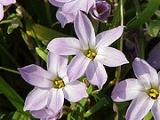
Tristagma uniflorum
Encyclopedia
Ipheion uniflorum is a species of flowering plant, related to the onions, so is currently placed in the Allium subfamily (Allioideae) of the Amaryllidaceae
. It is known by the common name spring star, or spring starflower. It was at one time transferred to the genus Tristagma, but recent research suggests that this was not correct. It is native to Argentina
and surrounding countries, but can be found elsewhere, such as much of the southern half of North America, as an introduced species
, possibly an escaped ornamental plant
. This is a perennial
herb growing from a bulb
and producing flat, shiny, green, hairless, grasslike leaves up to 30 centimeters long. The foliage has an onion
like scent when crushed. The stem grows up to 20 centimeters tall and bears a solitary showy flower in spring. Each star-shaped flower has six pointed lobes up to 3 centimeters long in shades of very pale to deep purple-blue.
Ipheion uniflorum has been grown in the UK since 1820, when bulbs collected from near Buenos Aires arrived in the country. It is recommended for growing in a well-drained position outside or as long-flowering pot plant in an unheated greenhouse. Various named forms are in cultivation, some of which may be hybrids. 'Wisley Blue' is a clear lilac blue; 'Froyle Mill' is a deeper violet blue; 'Album' is white. The cultivar 'Alberto Castillo', also white, has larger flowers and was collected in the 1980s by Alberto Castillo, the owner of Ezeiza Botanical Garden, from an abandoned Buenos Aires garden. In the USA, the species is stated to be hardy to USDA Zone 5, and is recommended for massing in borders, alpine gardens and other areas, or it can be naturalized in lawns.
Amaryllidaceae
Amaryllidoideae is the subfamily of flowering plants that takes its name from the genus Amaryllis. It is part of the family Amaryllidaceae, in order Asparagales...
. It is known by the common name spring star, or spring starflower. It was at one time transferred to the genus Tristagma, but recent research suggests that this was not correct. It is native to Argentina
Argentina
Argentina , officially the Argentine Republic , is the second largest country in South America by land area, after Brazil. It is constituted as a federation of 23 provinces and an autonomous city, Buenos Aires...
and surrounding countries, but can be found elsewhere, such as much of the southern half of North America, as an introduced species
Introduced species
An introduced species — or neozoon, alien, exotic, non-indigenous, or non-native species, or simply an introduction, is a species living outside its indigenous or native distributional range, and has arrived in an ecosystem or plant community by human activity, either deliberate or accidental...
, possibly an escaped ornamental plant
Ornamental plant
Ornamental plants are plants that are grown for decorative purposes in gardens and landscape design projects, as house plants, for cut flowers and specimen display...
. This is a perennial
Perennial plant
A perennial plant or simply perennial is a plant that lives for more than two years. The term is often used to differentiate a plant from shorter lived annuals and biennials. The term is sometimes misused by commercial gardeners or horticulturalists to describe only herbaceous perennials...
herb growing from a bulb
Bulb
A bulb is a short stem with fleshy leaves or leaf bases. The leaves often function as food storage organs during dormancy.A bulb's leaf bases, known as scales, generally do not support leaves, but contain food reserves to enable the plant to survive adverse conditions. At the center of the bulb is...
and producing flat, shiny, green, hairless, grasslike leaves up to 30 centimeters long. The foliage has an onion
Onion
The onion , also known as the bulb onion, common onion and garden onion, is the most widely cultivated species of the genus Allium. The genus Allium also contains a number of other species variously referred to as onions and cultivated for food, such as the Japanese bunching onion The onion...
like scent when crushed. The stem grows up to 20 centimeters tall and bears a solitary showy flower in spring. Each star-shaped flower has six pointed lobes up to 3 centimeters long in shades of very pale to deep purple-blue.
Ipheion uniflorum has been grown in the UK since 1820, when bulbs collected from near Buenos Aires arrived in the country. It is recommended for growing in a well-drained position outside or as long-flowering pot plant in an unheated greenhouse. Various named forms are in cultivation, some of which may be hybrids. 'Wisley Blue' is a clear lilac blue; 'Froyle Mill' is a deeper violet blue; 'Album' is white. The cultivar 'Alberto Castillo', also white, has larger flowers and was collected in the 1980s by Alberto Castillo, the owner of Ezeiza Botanical Garden, from an abandoned Buenos Aires garden. In the USA, the species is stated to be hardy to USDA Zone 5, and is recommended for massing in borders, alpine gardens and other areas, or it can be naturalized in lawns.

